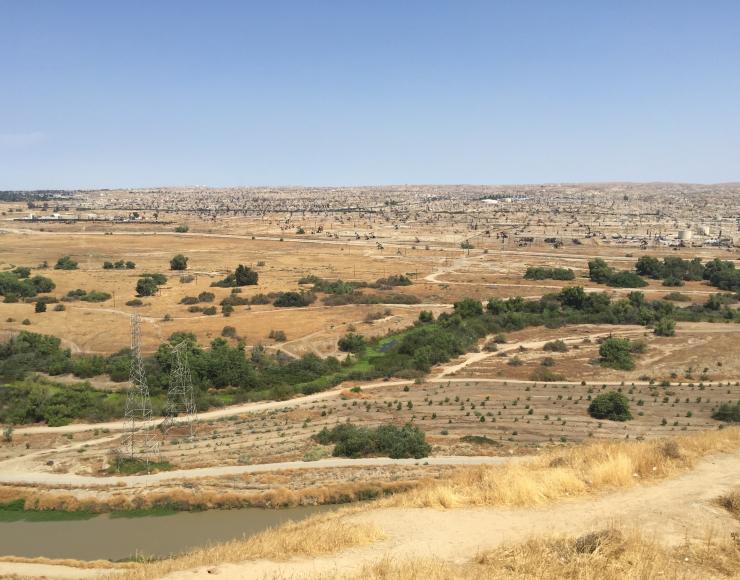The majority of oil and gas wastewater in California is injected into the geology beneath our feet. There are roughly 50,000 injection wells in California, most used to for enhanced oil recovery (EOR) techniques such as steam flooding, cyclic steam injection, and water flooding.
These techniques utilize a varying combination of freshwater and produced water (the wastewater from oil and gas production) depending on the quality of the wastewater from each formation or field.

Many of California's oil fields, like the Kern River Oil Field (pictured) near Bakersfield primarily utilizes steam injection to loosen the heavy oil and facilitate production. Energy and water intensive processes like steam injection contribute to the high carbon intensity of California produced fuels.
Some oil and gas wastewater is of too poor quality to be used in EOR operations, so it is disposed of by other means, such as injection into disposal wells. California has approximately 1,800 active disposal wells.
Both EOR and disposal by injection are regulated by the Division of Oil Gas and Geothermal Resources (DOGGR) as part of the Underground Injection Control (UIC) Class II program in the federal Safe Drinking Water Act (SDWA). DOGGR received primacy to regulate oil and gas wastewater disposal in the UIC program from the U.S. Environmental Protection Agency (EPA) in 1983. However DOGGR's management of the UIC program has come under scrutiny for major failures in recent years.
EPA Critique of the CA UIC Program
In 2011, EPA issued a critique of California's UIC program, citing numerous deficiencies: failing to protect for some potential underground sources of drinking water; one size fits all geologic review; and inadequate and under qualified staffing for carrying out inspections.
Aquifer Exemptions
Oil companies can only inject into formations that cannot be used as sources of drinking water, by either being too salty (above 10,000 parts per million total dissolved solids), or having received an Aquifer Exemption.
The Aquifer Exemption policy is the federal Safe Drinking Water Act (SDWA) program that allows groundwater to be sacrificed for the sake of oil and gas production. It removes SDWA protections from aquifers that would otherwise be classified as an Underground Source of Drinking Water. EPA can grant an exemption when aquifer meets certain criteria defined in SDWA (40 CFR § 146.4).
However, conditions have changed since the Aquifer Exemption policy was originally developed more than 30 years ago. Sacrificing underground aquifers to degradation at the hands of an industry is not consistent with California's goals of protecting water resources, especially in times of extreme drought. Developments in water treatment technology can transform once low quality aquifers into viable sources of drinking and irrigation water, and continuing drought will necessitate more of this in the future. Farmers and communities in search of water are drilling wells deeper than ever thought necessary, and desalinization is becoming more widespread. These developments demonstrate the need to protect aquifers that were once thought to be out of reach for human use.
Failed UIC Implementation
Beginning in July 2014, the state admitted to allowing oil and gas operators to inject into aquifers that may actually be sources of drinking water in thousands of cases. DOGGR's investigation revealed that more than 500 disposal wells and roughly 6,000 EOR wells were improperly permitted. The State is currently working to bring the program into compliance with federal regulations, however numerous wells continue to inject into non exempt aquifers.
Solutions
Clean Water Action is working to reform the way oil and gas waste is handled. At the federal level, we are pushing for improvements to SDWA and EPA oversight of the program. In California, we are working to strengthen UIC regulations and have succesffully engaged the State Water Resources Control Board in taking a more active role in the oversight of UIC wells, thereby increasing environmental review and scrutiny. The state budget that was passed in June, 2015 included a new process for state review of exemptions that included a public comment and public hearing. The State is now using this updated process which has resulted in numerous exemption denials, shut in wells and more oversight of the industry.
Additionally, DOGGR has begun a rulemaking process to update its UIC regulation. Clean Water Action is leading the effort to pass the most protective regulations possible.
Learn more about California's UIC program
- Aquifer Exemptions: Clean Water Action's National Campaign
- California Class II Underground Injection Control Program Review - Critique conducted for US EPA June 2011
- Ensuring Groundwater Protection: Is the Underground Injection Control Program Working? March 10, 2015 - Senate Natural Resources and Water and Senate Environmental Quality Committees
- Background Information
- Video Recording of Hearing March 10, 2015 Hearing.
- September 1982 US EPA Primacy Agreement 1
- December 1982 US EPA Primacy Agreement 2
- 1985 US EPA Letter to Western Oil and Gas Association specifying 11 aquifers in question are exempt
- 2010 internal memo from DOGGR supervisor to DOGGR personnel
- 2011 SB 855 annual report
- 2011 letter re: US EPA Audit
- Executive Summary of 2011 EPA Audit
- 2012 DOGGR "Road Map"
- November 2012 Action Plan from DOGR to US EPA
- June 2014 GAO Report Executive Summary
- July 2014 US EPA letter to DOGGR
- December 2014 US EPA letter to DOGGR
- August 2014 Work Plan
- February 6, 2015 DOGGR letter to US EPA and Work Plan for coming into compliance by February, 2017
- Cal EPA review of the UIC Program